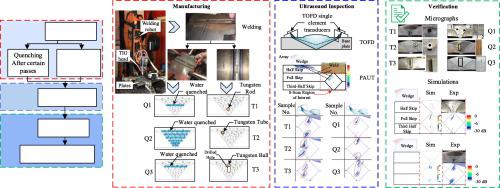当前位置:
X-MOL 学术
›
Mater. Des.
›
论文详情
Our official English website, www.x-mol.net, welcomes your
feedback! (Note: you will need to create a separate account there.)
Model-assisted ultrasonic calibration using intentionally embedded defects for in-process weld inspection
Materials & Design ( IF 7.6 ) Pub Date : 2021-01-01 , DOI: 10.1016/j.matdes.2020.109330 Ehsan Mohseni , Yashar Javadi , Nina E. Sweeney , David Lines , Charles N. MacLeod , Randika K.W. Vithanage , Zhen Qiu , Momchil Vasilev , Carmelo Mineo , Peter Lukacs , Euan Foster , S. Gareth Pierce , Anthony Gachagan
Materials & Design ( IF 7.6 ) Pub Date : 2021-01-01 , DOI: 10.1016/j.matdes.2020.109330 Ehsan Mohseni , Yashar Javadi , Nina E. Sweeney , David Lines , Charles N. MacLeod , Randika K.W. Vithanage , Zhen Qiu , Momchil Vasilev , Carmelo Mineo , Peter Lukacs , Euan Foster , S. Gareth Pierce , Anthony Gachagan

|
Abstract Automated in-process Non-Destructive Testing (NDT) systems are rapidly gaining traction within the manufacturing industry as they reduce manufacturing time and costs. When considering calibration and verification of such systems, creating defects of known geometry and nature during the deposition of a weld can: (I) help examine the capability of the automated system to detect and characterise defects, (II) be used to form a database of signals associated with different defect types to train intelligent defect classification algorithms, and (III) act as a basis for in-process gain calibration during weld inspection at high temperatures, where the ultrasound beam can be skewed as a result of velocity gradients. In view of this, this paper investigates two unique methodologies for introducing: (a) lack of fusion weld defects by embedding tungsten in the weld and (b) creating artificial weld cracks by quenching to imitate the real cracking scenarios. According to the results of Phased Array Ultrasound Testing (PAUT) inspections, the methodologies used for embedding the artificial defects were successful. The validity of inspections was also verified by extracting micrographs from the defective sections of the welds, and model-based simulations were carried out to gain a better understanding of the wave propagation path and interaction with the generated defects.
中文翻译:

使用有意嵌入缺陷的模型辅助超声波校准进行过程焊接检测
摘要 自动化过程中无损检测 (NDT) 系统由于减少了制造时间和成本而在制造业中迅速受到关注。在考虑校准和验证此类系统时,在焊缝熔敷期间创建已知几何形状和性质的缺陷可以:(I) 帮助检查自动化系统检测和表征缺陷的能力,(II) 用于形成数据库与不同缺陷类型相关的信号,以训练智能缺陷分类算法,以及 (III) 在高温焊缝检测期间作为过程中增益校准的基础,在这种情况下,超声波束可能因速度梯度而发生偏斜。鉴于此,本文研究了两种独特的引入方法:(a) 通过在焊缝中嵌入钨来减少熔焊缺陷和 (b) 通过淬火来模拟真实的开裂情况来产生人工焊缝裂纹。根据相控阵超声测试 (PAUT) 检查的结果,用于嵌入人工缺陷的方法是成功的。还通过从焊缝缺陷部分提取显微照片来验证检查的有效性,并进行基于模型的模拟,以更好地了解波传播路径以及与产生的缺陷的相互作用。
更新日期:2021-01-01
中文翻译:

使用有意嵌入缺陷的模型辅助超声波校准进行过程焊接检测
摘要 自动化过程中无损检测 (NDT) 系统由于减少了制造时间和成本而在制造业中迅速受到关注。在考虑校准和验证此类系统时,在焊缝熔敷期间创建已知几何形状和性质的缺陷可以:(I) 帮助检查自动化系统检测和表征缺陷的能力,(II) 用于形成数据库与不同缺陷类型相关的信号,以训练智能缺陷分类算法,以及 (III) 在高温焊缝检测期间作为过程中增益校准的基础,在这种情况下,超声波束可能因速度梯度而发生偏斜。鉴于此,本文研究了两种独特的引入方法:(a) 通过在焊缝中嵌入钨来减少熔焊缺陷和 (b) 通过淬火来模拟真实的开裂情况来产生人工焊缝裂纹。根据相控阵超声测试 (PAUT) 检查的结果,用于嵌入人工缺陷的方法是成功的。还通过从焊缝缺陷部分提取显微照片来验证检查的有效性,并进行基于模型的模拟,以更好地了解波传播路径以及与产生的缺陷的相互作用。











































 京公网安备 11010802027423号
京公网安备 11010802027423号